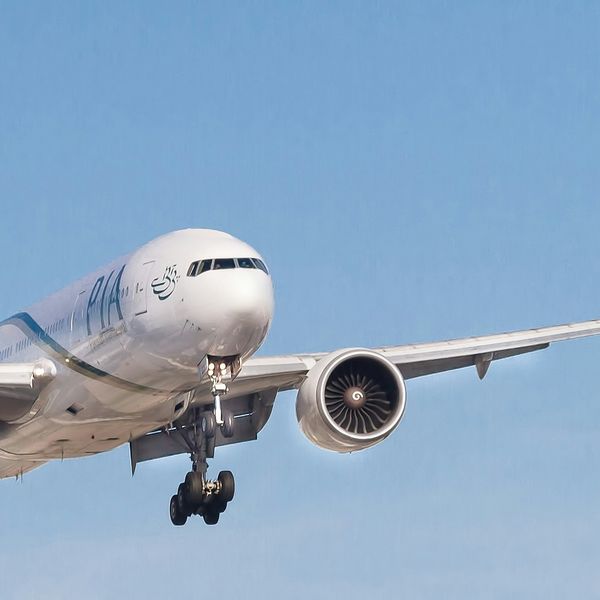Reuters
News Agency Partner
Reuters is a leading source of news and information, delivering fact-based reporting and expert analysis on international events and trends.
News Desk
The News Desk provides timely and factual coverage of national and international events, with an emphasis on accuracy and clarity.

Anna Menon, Scott Poteet, commander Jared Isaacman and Sarah Gillis, crew members of Polaris Dawn, at a press conference at the Kennedy Space Center in Cape Canaveral, Florida, U.S. August 19, 2024.
REUTERS
The mission set a new record by reaching a maximum altitude of 1,400 km (870 miles), higher than any human has flown since the last Apollo mission in 1972.
Billionaire Jared Isaacman, and SpaceX operations engineer Sarah Gillis became the first non-professional astronauts to perform a spacewalk
SpaceX's Polaris Dawn crew has successfully returned to Earth after spending five days in orbit, marking a historic achievement with the world's first commercial spacewalk.
The Dragon capsule splashed down off the coast of Florida at 3:37 a.m. ET Sunday , with the event streamed live by SpaceX.
"Splashdown of Dragon confirmed! Welcome back to Earth," SpaceX announced on social media platform X, formerly known as Twitter.
NASA hailed the mission as "a giant leap forward" for the commercial space industry.

The crew orbited inside the Dragon spacecraft, named Resilience, for five days after launching from the Kennedy Space Center in Florida on Tuesday morning. The mission set a new record by reaching a maximum altitude of 1,400 km (870 miles), higher than any human has flown since the last Apollo mission in 1972.
Dangerous Mission
Returning to Earth is among the most dangerous stretches of any space mission.
To safely reach home, the Crew Dragon capsule carried out what’s called a “de-orbit burn,” orienting itself as it prepared to slice through the thickest part of Earth’s atmosphere.
The spacecraft then reached extremely hot temperatures — up to 3,500 degrees Fahrenheit (1,900 degrees Celsius) — because of the pressure and friction caused by hitting the air while still traveling around 17,000 miles per hour (27,000 kilometers per hour).
The crew, however, should have remained at comfortable temperatures, protected by the Crew Dragon’s heat shield, which is located on the bottom of the 13-foot-wide (4-meter-wide) capsule.
Dragging against the air began to slow the vehicle down before the Crew Dragon deployed parachutes that further decelerated its descent.
Having hit the ocean, the spacecraft briefly bobbed around in the water until rescue crews waiting nearby hauled it out of the ocean and onto a special boat, referred to as the “Dragon’s nest.” Final safety checks took place there before the crew disembarked from the capsule and began the journey back to dry land.
During their mission, the crew used the SpaceX Starlink satellite network on Saturday to establish a direct video link to Earth.
Live broadcasts and a musical performance
The mission was funded by Jared Isaacman, billionaire CEO of a finance company, he was also the mission commander. Jared was joined by his close friend and former US Air Force pilot Scott “Kidd” Poteet; and SpaceX operations engineers Anna Menon and Sarah Gillis. Time magazine estimated that Mr Isaacman paid $200m to fellow billionaire Elon Musk for all four seats aboard the SpaceX craft.
Isaacman and Gillis became the first non-professional astronauts to perform a spacewalk, a complex maneuver that requires exiting the spacecraft. Previously, only government-funded space agency astronauts had attempted such feats.
Live broadcasts showed the two crew members emerging from the Dragon capsule and floating 435 miles (700 km) above Earth. During the spacewalk, Isaacman remarked to mission control in Hawthorne, California, “Back at home we all have a lot of work to do, but from here — looks like a perfect world."
“Back at home we all have a lot of work to do, but from here — looks like a perfect world."
Due to the Dragon spacecraft lacking an airlock, the crew were directly exposed to the vacuum of space during the spacewalk. This spacewalk set a new record for altitude, made possible by innovative astronaut suits equipped with advanced technology.
Over the five-day mission, the crew conducted more than 40 experiments, including studies on the impact of space travel on human health and testing inter-satellite laser communication between the Dragon spacecraft and SpaceX's Starlink satellites.
Gillis, who is also a trained violinist, performed “Rey’s Theme” from Star Wars: The Force Awakens from orbit. Her performance, streamed to Earth via the Starlink network, was part of a collaborative effort with orchestras on the ground. This video was created in partnership with St. Jude Children's Research Hospital, for which the Polaris Program was raising funds during the mission.
Polaris Dawn is the first of three planned missions in the Polaris Program, a partnership between Isaacman and SpaceX. Future missions include the first crewed flight of SpaceX's new Starship rocket, which is still under development.








Comments
See what people are discussing